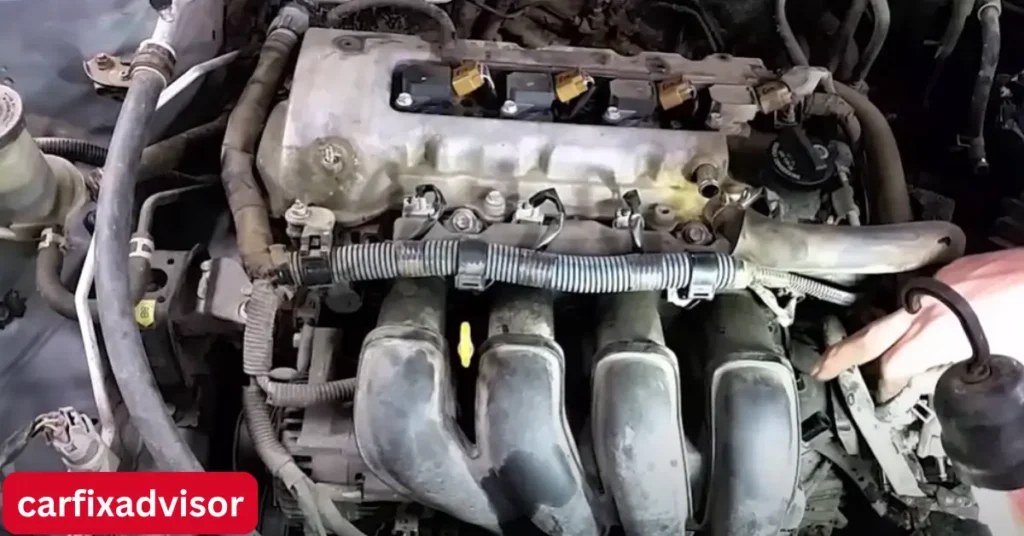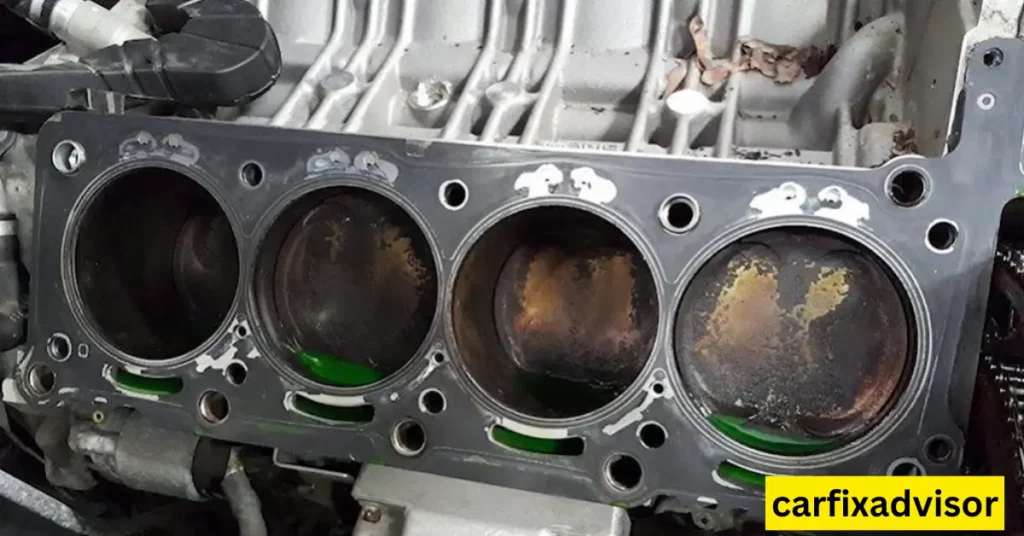A bad intake manifold gasket can lead to serious issues in your engine, and it’s important to understand the risks of continuing to drive with this problem. An intake manifold gasket seals the intake manifold to the engine block, preventing air and coolant leaks. Over time, this gasket can degrade, leading to poor engine performance and potentially more significant damage if left unchecked.
But how long can you actually Drive a Car with a Bad Intake Manifold Gasket? This article explores the symptoms, risks, and potential consequences of driving with a bad intake manifold gasket, helping you make an informed decision about whether to keep driving or seek repairs.
What is an intake manifold gasket?
Before diving into the risks and symptoms, let’s define what an intake manifold gasket is and its role in your engine.
Key Terms:
-
Intake Manifold: This is the part of the engine that takes in air from outside and funnels it into the engine’s cylinders, where it mixes with fuel to form the air-fuel mixture necessary for combustion.
-
Gasket: A gasket is a sealing component used to prevent leakage of fluids or gases between engine components. In the case of the intake manifold gasket, it seals the junction between the intake manifold and the engine block.
-
Engine Block: The main structure of an engine, where the internal components are housed, including the cylinders.
The intake manifold gasket ensures that no air or coolant leaks between the intake manifold and the engine block. A properly sealed gasket is crucial for the engine’s performance and efficiency.
Symptoms of a Bad Intake Manifold Gasket
Before you decide how long you can drive with a bad intake manifold gasket, it’s important to recognize the symptoms that indicate the gasket is failing. Here are the most common signs of a damaged intake manifold gasket:
-
Coolant Leaks
-
If coolant begins to leak from the intake manifold gasket, you may notice a puddle of coolant under the car or a drop in the coolant levels. This can lead to engine overheating and damage if not addressed promptly.
-
-
Rough Engine Idle
-
A leaking intake manifold gasket can cause air to enter the engine in an uncontrolled manner, disrupting the air-fuel mixture. This can cause the engine to idle roughly or sputter when idling, making the car feel unsteady or shaky.
-
-
Engine Misfire
-
When the intake manifold gasket fails, it can cause an improper air-fuel mixture. This results in misfires, particularly at low RPMs, leading to poor performance and inefficient fuel consumption.
-
-
Poor Acceleration
-
If the gasket is letting in unregulated air, your engine may struggle to accelerate smoothly. You might notice a hesitation or lag when pressing the gas pedal.
-
-
Check Engine Light
-
A faulty intake manifold gasket can trigger the check engine light. Your vehicle’s computer will detect an irregularity in air or coolant flow, signaling the need for a diagnosis.
-
-
Unusual Engine Sounds
-
You may hear hissing or sucking noises from the intake manifold area, which can indicate a leak in the gasket.
-
-
Loss of Coolant Without Visible Leaks
-
In some cases, the intake manifold gasket leak is internal, meaning you might not see coolant on the ground, but the coolant level will drop significantly. This can lead to engine overheating.
-
How Long Can I Drive with a Bad Intake Manifold Gasket?
The short answer is: it depends on the severity of the damage. Let’s break down the different scenarios based on the level of damage to your intake manifold gasket.
1. Minor Leakage
-
If the gasket is only slightly damaged, you may be able to drive for a limited period without immediate catastrophic failure. However, this is not ideal. If you continue driving with a minor leak, you could experience rough idling, poor acceleration, and coolant loss. Over time, the leak can worsen, leading to more serious issues.
-
Estimated Time to Drive: A few hundred miles or a week or two, but it’s best to get it fixed soon to avoid worsening conditions.
2. Moderate Damage
-
With moderate damage, you may start noticing symptoms like misfires, engine overheating, or a substantial coolant leak. Continuing to drive under these conditions can lead to engine misfires that damage other engine components like the spark plugs or the catalytic converter.
-
Estimated Time to Drive: You might be able to drive for a few days or a week, but the risks increase. Engine damage could occur if the gasket leak isn’t addressed.
3. Severe Damage
-
If your intake manifold gasket is severely damaged or completely blown, you should not drive the vehicle at all. Continuing to drive with a severe leak can lead to extensive engine damage. For example, you may overheat the engine, leading to the potential for a blown head gasket or worse.
-
Estimated Time to Drive: You should not drive at all if the gasket is severely damaged. Immediate repair is necessary.
Risks of Driving with a Bad Intake Manifold Gasket
Driving with a bad intake manifold gasket can lead to several risks, some of which can result in severe engine damage and costly repairs. Here are the most significant risks:
-
Engine Overheating
-
If coolant is leaking due to a damaged intake manifold gasket, it can lead to engine overheating. This can cause the engine to seize, leading to expensive repairs or a total engine replacement.
-
-
Engine Misfire
-
A leaking intake manifold gasket can result in an improper air-fuel mixture, causing the engine to misfire. Misfires can damage the spark plugs, the catalytic converter, and other critical engine components.
-
-
Catalytic Converter Damage
-
Misfires caused by a bad intake manifold gasket can lead to unburned fuel entering the exhaust system, which may damage the catalytic converter. Replacing a catalytic converter can be very expensive.
-
-
Increased Fuel Consumption
-
A leaking intake manifold gasket can disrupt the air-fuel mixture, causing the engine to run inefficiently and consume more fuel. This not only affects performance but also decreases fuel economy.
-
-
Risk of Total Engine Failure
-
In extreme cases, continued driving with a bad intake manifold gasket can lead to total engine failure. If coolant enters the combustion chamber, it can lead to engine corrosion, which could render the engine inoperable.
-
 How Long Can I Drive a Car with a Bad Intake Manifold Gasket
How Long Can I Drive a Car with a Bad Intake Manifold Gasket
Diagnosing a Bad Intake Manifold Gasket
Properly diagnosing a bad intake manifold gasket is essential to understanding the extent of the problem. Here are the steps you can take to confirm the issue:
1. Visual Inspection
-
Start by visually inspecting the intake manifold gasket area for visible signs of coolant leakage. Look for puddles or coolant residue around the intake manifold. A damaged gasket may show coolant stains or corrosion in the area.
2. Check for Coolant Leaks
-
If you notice a significant drop in coolant levels without visible leaks on the ground, the intake manifold gasket might be the culprit. This can also result in engine overheating. Top off the coolant and monitor if the levels continue to drop rapidly.
3. Use of Dye
-
Some mechanics use special dye to check for coolant leaks. The dye is added to the coolant system and can be traced under UV light, helping pinpoint the source of the leak.
4. Compression Test
-
A compression test measures the pressure within the engine’s cylinders. If the intake manifold gasket is leaking, you may see a loss of compression in one or more cylinders, which can confirm a problem with the gasket.
5. Smoke Test
-
A smoke test involves introducing smoke into the intake manifold system. If the gasket is faulty, the smoke will escape through the damaged area, confirming the leak.
How to Repair or Replace a Bad Intake Manifold Gasket
Once you’ve confirmed that the intake manifold gasket is the issue, it’s time to take action. Below is a step-by-step guide on how to repair or replace the gasket.
1. Tools You Will Need
-
Socket set
-
Torque wrench
-
Gasket scraper
-
New intake manifold gasket
-
RTV (room-temperature vulcanizing) sealant (if required)
-
Gasket sealing material
2. Step-by-Step Repair Process
-
Step 1: Preparation
-
Disconnect the battery to avoid any electrical accidents.
-
Drain the coolant from the system to avoid spills when the intake manifold is removed.
-
-
Step 2: Removing the Intake Manifold
-
Unbolt and remove any components obstructing access to the intake manifold, such as hoses, air filters, or throttle body.
-
Remove the bolts securing the intake manifold to the engine block. Use a socket wrench to loosen and remove them carefully.
-
-
Step 3: Clean the Area
-
Once the manifold is removed, clean the surface area of the engine block and intake manifold. Remove any old gasket material or residue to ensure a good seal for the new gasket.
-
-
Step 4: Install the New Gasket
-
Place the new intake manifold gasket onto the engine block. Ensure it aligns perfectly with the mounting holes and surfaces. If needed, apply RTV sealant to the edges of the gasket to ensure a tight seal.
-
-
Step 5: Reinstall the Intake Manifold
-
Carefully reinstall the intake manifold, aligning it with the gasket and the mounting holes. Tighten the manifold bolts evenly in a crisscross pattern, following the manufacturer’s recommended torque specifications.
-
-
Step 6: Reassemble and Test
-
Reattach all previously removed components, including hoses, air filters, and the throttle body.
-
Refill the coolant system and reconnect the battery.
-
Start the engine and check for any leaks or irregularities in engine performance. Monitor coolant levels and idle quality.
-
 How Long Can I Drive a Car with a Bad Intake Manifold Gasket
How Long Can I Drive a Car with a Bad Intake Manifold Gasket
How Much Does It Cost to Replace an Intake Manifold Gasket?
The cost of replacing an intake manifold gasket varies depending on your vehicle’s make and model, as well as labor costs in your area. On average, the cost can range from $300 to $1,000 or more, with the breakdown as follows:
-
Parts: The intake manifold gasket itself usually costs between $30 and $150, depending on the vehicle.
-
Labor: Labor charges for this repair can range from $150 to $600, depending on the complexity of the job.
-
Total Cost: The overall cost of replacing an intake manifold gasket typically falls between $300 and $1,000, but it can be higher for luxury or performance vehicles.
Preventing Intake Manifold Gasket Issues
While you can’t always prevent intake manifold gasket failure, you can take steps to minimize the chances of it happening and extend the life of the gasket.
1. Regular Maintenance
-
Regularly check your vehicle’s coolant levels and look for signs of leaks or unusual engine behavior. Routine maintenance helps detect early signs of gasket failure before it leads to more severe issues.
2. Keep Engine Temperature Stable
-
Overheating is one of the most significant causes of gasket failure. Ensure that your vehicle’s cooling system is functioning correctly by checking for any signs of coolant loss, radiator issues, or malfunctioning thermostats.
3. Avoid Engine Overheating
-
Avoid running the engine in excessively hot conditions or letting it overheat. Consistently running your car at high temperatures will put more strain on the gasket, causing it to degrade faster.
4. Address Leaks Promptly
-
If you notice any coolant leaks or engine performance issues early on, address them as soon as possible to prevent further damage to the intake manifold gasket.
Conclusion: Drive a Car with a Bad Intake Manifold Gasket
If you suspect that you have a bad intake manifold gasket, it’s important to address the issue as soon as possible. While minor damage may allow you to drive for a short time, ignoring the problem can lead to more serious engine damage and costly repairs. Diagnosing and replacing a faulty intake manifold gasket can restore your engine’s performance and prevent further issues down the line.
If you’re unsure of the condition of your gasket or need help with the repair, it’s always best to consult with a qualified mechanic who can assess the situation and make the necessary repairs.
